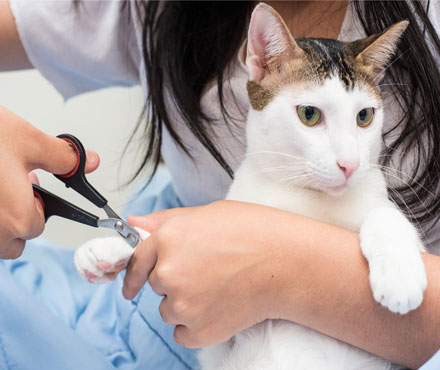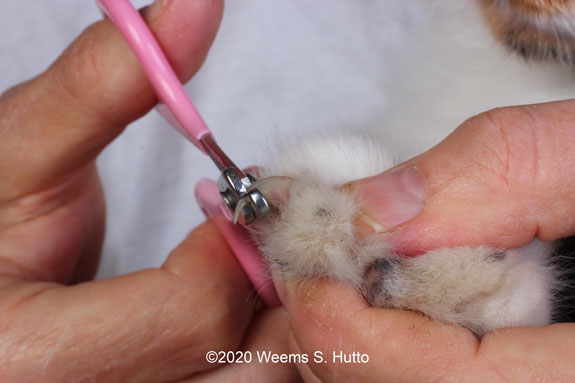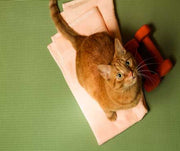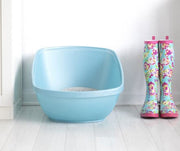Clipping Your Cats Nails

Clipping Your Cats Nails

This article was written by feline health and behavior expert, Dusty Rainbolt. She is the award-winning author of Cat Scene Investigator: Solve Your Cat's Litter Box Mystery, Finding Your Lost Cat: The Practical Cat-Specific Guide for Your Happy Reunion, and Kittens for Dummies. She is a feline behavior consultant, the past president of Cat Writers' Association, and has been an in-the-trenches cat and kitten rescuer for over three decades. You can learn more about her at: www.dustycatwriter.com
Cats love their claws. Cats use them for protection, communication, climbing, and exercise, non of which humans appreciate. For your kitty comfort and to protect our skin and furniture, Fluffy's nails should be trimmed every four weeks.
No question, nail trims are at the bottom of a long list of things your cat wants to do, just above having blood drawn at the vet. If the idea of cutting your cat's claws elicit images of emergency room visits, tourniquets and sutures, don't worry. I'm going to help you turn your cat into a willing pedicure participant.
Of course, it's best if you start trimming Fluffy's nails as soon as your new kitten joins the family. Once he's accustomed to handling, monthly nail trims will soon become just a fact of life.
If you've never cut Fluffy's nails before or if he's had a bad experience, go slow and give him an incentive to accept having his feet handled. You've got this!
PROVIDING MOTIVATION
The key to Fluffy's cooperation in the battle of the toenails is to determine his favorite treat in the entire world. You've heard the adage, "You attract more flies with honey than vinegar." Let's change that to, "You trim more nails with tuna." Give Fluffy a reason to want to get his nails trimmed. Offer treats after each successful trim and a mega bonus when you finish, and he will begin to associate good things with having his paws handled. And by treat, I don't mean the yucky baked cat treats you pick up at the grocery store. I'm talking about a treat so appealing, he is willing to do anything to get it.
Smokey, a Russian Blue, wouldn't let his owner touch his paws, much less trim his nails, so she asked me to work with him. Through experimentation, I found out he was a certified tune flake addict. Every time I touched his paws I rewarded him. Later, during the same session, I began pressing his toe pads to extend his claws, again rewarding him after each toe. By the end of the session, I had trimmed two claws. After a couple of months, when I would visit, Smokey would head bump me until I trimmed his nails and he got paid.
Most cats would like tuna flakes, canned tuna, turkey baby food, or pencil eraser-sized pieces of deli turkey (low sodium). You may have to experiment, but once you discover you cat's food obsession, only give him this treat during his pedicure. To add more incentive to cooperate, be sure to clip nails before you feed him.
He gets a treat every toe success. When acclimating an adult cat, start by gently stroking the tops of the feet. Follow this with a treat. Graduate to massaging his pads. Reward. Press gently on his toe pad to push the claw out. Then offer a treat. When you cat is comfortable with touching, try cutting a few nails. Always end the session with a big jackpot. Keep sessions short. You don't have to trim all 18 nails at once.
ITS TOE NAIL TIME

Use nail clippers designed specifically for cats. They are smaller and easier to control. Also, if Fluffy has already had bad experiences of the toenail kind, you can easily hide them in your hand as your approach him. I find that the JW Gripsoft Cat Nail Clippers work best for my cats (shown to the right). Mine are pink, but they come in a variety of colors.
Never use guillotine nail cutters on a cat. Guilltines can cut deeply into the quick of a stuggling cat. Also, they can cause painful nail splits; sometimes nails can crack along the length of the quick.
Stay calm. Never yell at or hit your kitty, even if he's struggling or hissing. This will make him afraid of your and getting his nails trimmed.
You might need to enlist help when trimming the cat's nails. As you begin handling the paw, you have an assistant to distract Fluffy with turkey baby food on a tongue depressor or a spoon.
Place the cat on the kitchen counter top. This allows you to stand in a natural position with the cat safely restrained in the crook of your arm. The slick surface prevents Fluffy from gaining traction and getting away.

Expose the nail by gently pressing the toe pad with your thumb and index finger like shown above. Locate the pink quick. The quick is actually the vein that carries blood to the nail. If the cat has dark claws, you can see the quick from the underside. A drop of baby oil or mineral oil on the nail will make the quick easier to see. Take care. Cutting into the quick is very painful. If you quick your cat, there's no treat in the world that will inspire his cooperation in the future.
Snip off only the small hook or about one-eighth of an inch of the claw (shown below). If his claws are very long, remove only a little and repeat the process next week when the blood vessels have bad a chance to retreat back into the nail. Continue to do this until the nails are the desired length.

Praise your cat throughout the procedure and reward after each snip. Even if you just cut a single nail, you have both accomplished a great deal. Praise him, and don't forget his reward. Tomorrow you can try for another toenail or two. At that rate, it will only take a week to finish and neither of you will be too traumatized. End the session with "Good job!" and a pile of treats.
Once he grows accustomed to having his feet safely handled, the two of you should be able to expect an unevenful monthly pedicure.
Be patient. Don't get into a battle. If he becomes antsy, end on a positive note and try again later.
Previous article

Next article

Related posts
View all-

Can My Dog Learn to Use the Cat Litter Box?
Some owners wonder: can dogs learn to use a cat litter box? It’s a practical solution for small, older, and even puppies. If cats can do it, why not our canine companions? The idea sounds simple enough, but it’s not as straightforward as tossing down a litter pan and expecting results. Dogs have different instincts, and training methods vary. Without the correct litter box, consistent training, and proper rewards, it may seem impossible.
Read Article -

How Do You Make a Bed for a Cat
Making a bed for your cat is a fun, creative, and cost-effective project. Cats love to curl up in soft, cozy spaces, and creating a custom bed ensures your furry friend has the perfect place to rest. Whether you’re using an old sweater, cardboard boxes, or spare fabric, a homemade cat bed can be just as comfy as store-bought cat furniture. You can make a bed matching your kitty’s personality and home décor with basic sewing skills and simple materials.
Read Article -

How Do I Get My Dog to Share Her Toys with the New Puppy
Bringing home a new puppy is exciting, but it can also bring unexpected challenges to your household. One of the most common struggles dog owners face is getting their older dog to share toys or space with the new pup. While it’s normal for dogs to feel possessive of their belongings, this behavior can escalate if not addressed.
Read Article



